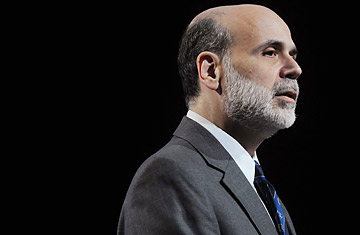
Federal Reserve Chairman Ben Bernanke
The stock market stormed up Thursday on good earnings news from the bank sector, but there was bad news on another front that could undermine the surge. The second round of the Federal Reserve's attempt to restart the nonbank consumer-lending market, the so-called TALF program, went even worse than the faltering first round did last month. The poor performance is causing some Fed officials to doubt the entire premise of the effort to restart nonbank credit markets. "We know there are people out there interested in putting subscriptions together," says a Fed official, "but the larger question is, Where is the market [for them]?"
The New York Federal Reserve says the second round of TALF lending amounts to just two issues for $1.7 billion in loans, divided roughly equally between auto and credit cards. The $1.7 billion is well below the $4.7 billion in loans from last month. Fed officials say they will return after the holiday weekend to try and get a sense of why the subscription was so light. (Read "Doubts Raised About Government Plan to Boost Consumer Lending.")
The TALF program (Term Asset-Backed Securities Loan Facility), funded with up to $200 billion, was created to provide liquidity to the market for securitized nonbank consumer loans. The prospective buyers of such securities would be hedge funds and investment firms.
There are three possible reasons for the shortfall in demand. First, there have been disagreements over terms between some of the dealers who are packaging consumer loans and the investors they want to sell them to. The New York Fed has engaged both sides in several of these disputes and believes it can resolve the problems, says the Fed official. The second potential reason for the TALF shortfall is fear of retroactive penalties from Washington. "There's nervousness about the possibility of retroactive action by Congress," says a government official.
The last possibility may be the most worrying — that there has been a fundamental shift in the appetite for nonbank securitized loans, which previously represented some 40% of U.S. consumer lending. "The Fed and Treasury have said we're prepared to lend up to $200 billion for small business, auto, student and other kinds of loans, but what is the market for them?" says the Fed official. "You still have to figure out what the demand is at this point, because of the state of the economy and whether people are comfortable doing these [securitized nonbank loans]."
A dramatic drop in demand could be either very good or very bad for traditional banks. It could mean that the nonbank, or "shadow bank," system is less appealing to borrowers than traditional banks in uncertain times, and so they are going to regular banks for loans instead. Or more ominously, it could mean there is an overall dramatic drop in borrowing, which would hurt everybody.
